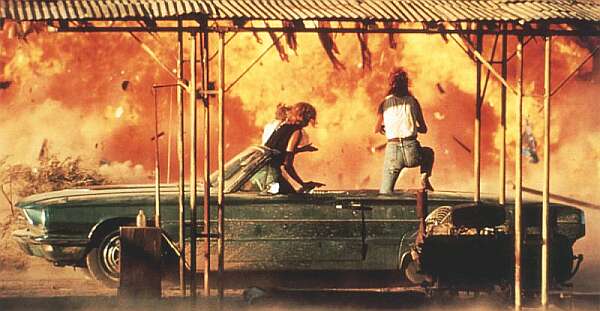 ★★★★
★★★★
“Two Bitches in a Car.”

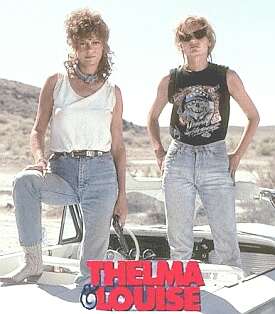 But to quote one character in the movie, “Bitches from hell“… :-) Guess a spoiler alert is needed, though I suspect 90% of readers know how this ends. Better safe than sorry though. That said, it’s possible to pinpoint precisely the pivotal moment in Thelma and Louise. A thug is raping Thelma (Davis) in the parking lot of a bar. Louise (Sarandon) comes out, sees the assault, and puts a gun to the attacker’s head. The man freezes, and Thelma wriggles away. But when he tells Louise to “Suck my cock!”, she guns him down anyway.
But to quote one character in the movie, “Bitches from hell“… :-) Guess a spoiler alert is needed, though I suspect 90% of readers know how this ends. Better safe than sorry though. That said, it’s possible to pinpoint precisely the pivotal moment in Thelma and Louise. A thug is raping Thelma (Davis) in the parking lot of a bar. Louise (Sarandon) comes out, sees the assault, and puts a gun to the attacker’s head. The man freezes, and Thelma wriggles away. But when he tells Louise to “Suck my cock!”, she guns him down anyway.
It’s a shocking climax to a highly disturbing scene. Writer Callie Khouri made a very conscious decision for the ‘victim’ – quotes used advisedly – not to be a threat when he dies, and it leaves the viewer with really only two options. Lose empathy for a character capable of such a crime; or, somehow, accept that it’s okay to shoot someone for what they say. [Rumblings of a previous incident in Texas are hardly a defence] To reverse things, any movie where the hero gunned down a mouthy woman would not, I feel, get an Oscar for Best Original Script, or be described as “empowering”.
This is brave, but seems designed to fit her agenda better than the needs of the audience. Indeed, much the same could be said of the whole script, which can be summarised in four words: all men are bastards. The problem is, cliches are cliches, regardless of what sex they are. Every man is reduced to a crude stereotype – mostly petulant boys – even Harvey Keitel’s stoic cop (with an Arkansas accent this Brit knew was lame) demands T&L do things his way. On the other hand, the script goes out of its way to ensure every woman is portrayed sympathetically, down to the truckstop waitress.
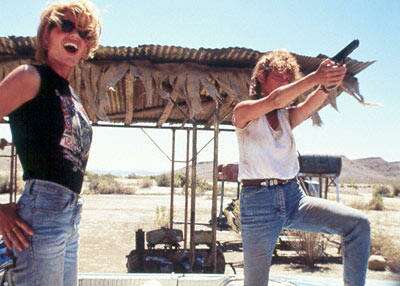 It becomes like having Andrea Dworkin yelling in your face for two hours, yet the film’s moral is that if women empower themselves, death inevitably results. Khouri seems to be saying, “You can only beat the system by suicide,” while the patriarchy watches from behind its sunglasses and firearms. We win, guys – now, let’s go back to our Bud and football, while the little ladies make us dinner. With such confused writing, little wonder one studio executive’s opinion, as given to Ridley Scott, was the quote headlining this article. Khouri, meanwhile, largely vanished until 2002’s Divine Secrets of the Ya-Ya Sisterhood. However, if you need proof that a mediocre script can be salvaged by acting and directing, this is it. Between them, Davis, Sarandon and Scott (plus cinematographer Adrian Biddle) bring incredible depth to the characters and their story. No further proof is needed than to contemplate some of the other pairings who were mooted for the film: Jodie Foster and Michelle Pfeiffer or, god help us, Meryl Streep and Goldie Hawn.
It becomes like having Andrea Dworkin yelling in your face for two hours, yet the film’s moral is that if women empower themselves, death inevitably results. Khouri seems to be saying, “You can only beat the system by suicide,” while the patriarchy watches from behind its sunglasses and firearms. We win, guys – now, let’s go back to our Bud and football, while the little ladies make us dinner. With such confused writing, little wonder one studio executive’s opinion, as given to Ridley Scott, was the quote headlining this article. Khouri, meanwhile, largely vanished until 2002’s Divine Secrets of the Ya-Ya Sisterhood. However, if you need proof that a mediocre script can be salvaged by acting and directing, this is it. Between them, Davis, Sarandon and Scott (plus cinematographer Adrian Biddle) bring incredible depth to the characters and their story. No further proof is needed than to contemplate some of the other pairings who were mooted for the film: Jodie Foster and Michelle Pfeiffer or, god help us, Meryl Streep and Goldie Hawn.
I hadn’t seen this since its original release over a decade ago. At the time, I remember being more impressed by Davis’ performance; now, my opinion has changed, and Sarandon comes across better. This is partly because Thelma is such a dumb broad, who behaviour is initially more like that of a hormone-crazed teenager. Within hours of nearly being raped – hey, you go line-dancing, whaddya expect? – she’s virtually sliding off the car seat when she sees cowboy JD (Pitt, though the role almost went to another then-unknown: George Clooney). She knows he’s a criminal, yet leaves six grand on the bedside table for him to steal. Oops! Silly Thelma!
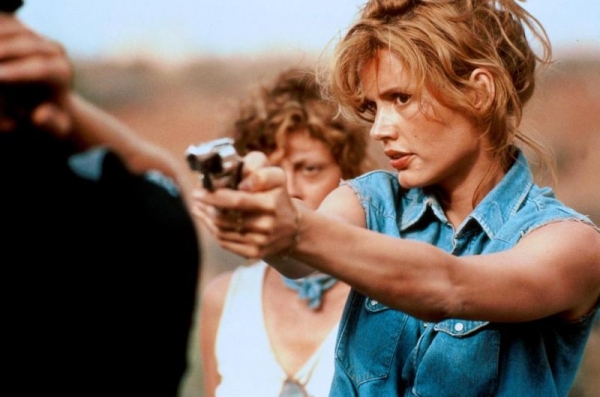 It’s impossible to blame her for long, however, and the character development is fascinating. She starts the subordinate, but it’s Thelma who robs the convenience store to fund their journey to Mexico (a great place to escape male oppression…), locks a whimpering cop in the trunk of his car, and suggests they should die rather than tamely accept capture. While Louise initially seems to be the stronger, the cracks begin to show before long, not least in her near-hysterical refusal to enter Texas, regardless of the resulting detour.
It’s impossible to blame her for long, however, and the character development is fascinating. She starts the subordinate, but it’s Thelma who robs the convenience store to fund their journey to Mexico (a great place to escape male oppression…), locks a whimpering cop in the trunk of his car, and suggests they should die rather than tamely accept capture. While Louise initially seems to be the stronger, the cracks begin to show before long, not least in her near-hysterical refusal to enter Texas, regardless of the resulting detour.
These are two fabulous portrayals – unlike Khouri, fully deserving their Oscar nominations (the statue went to Jodie Foster for Silence of the Lambs) – which salvage potentially laughable moments with convincing emotion that blows away the script deficiencies. And in contrast to the grim ugliness of their predicament is the luminous postcard photography of mythic America, in the shape of oil-wells, ruler-straight roads, pylons and buttes, on their way to that quintessential American location, the Grand Canyon. [Actually Utah’s Deadhorse Point]
Certainly, it has to be considered one of the most important entries in the GWG genre, and despite its flaws, this film struck a chord which resonates even now. Perhaps its most powerful testament is a creepy little fact I found in Over the Edge: Death in the Grand Canyon [Ghigieri and Myers, Puma Press, 2001]. It has been possible to commit suicide by driving off the South Rim of the Grand Canyon for about eighty years. Almost one-third of all those who chose this method, did so in 1993, the year after Thelma and Louise came out on home video…
Dir: Ridley Scott
Star: Geena Davis, Susan Sarandon, Harvey Keitel, Brad Pitt
 Yeoh’s English-language follow-up to Crouching Tiger was highly anticipated, but the end result is a disappointment. Yeoh plays Yin, the head of a family of acrobats who guard part of the key to a Sharira – a holy relic with potential for good or evil. The latter is supplied by Carl (Roxburgh), who hires Yin’s former boyfriend Eric (Chaplin) to steal the other elements needed to get the Sharira. Eric, however, switches sides, and teams up with Yin to race Carl to the prize.
Yeoh’s English-language follow-up to Crouching Tiger was highly anticipated, but the end result is a disappointment. Yeoh plays Yin, the head of a family of acrobats who guard part of the key to a Sharira – a holy relic with potential for good or evil. The latter is supplied by Carl (Roxburgh), who hires Yin’s former boyfriend Eric (Chaplin) to steal the other elements needed to get the Sharira. Eric, however, switches sides, and teams up with Yin to race Carl to the prize.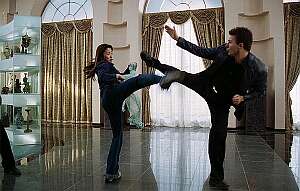 Worst of all, given a $20m budget, you’d think the climax would be more than extremely lame CGI, barely worthy of a Playstation game. Yeoh is her own best special effect, and the finale gives her little or no chance to shine. I suspect she’d have been better off taking a part in the Matrix sequels, which she turned down in order to make this mediocre action-adventure entry. Little wonder Miramax pushed the US release back to Spring 2004 – almost two years after the HK release. Do not be surprised if it quietly gets dumped to video.
Worst of all, given a $20m budget, you’d think the climax would be more than extremely lame CGI, barely worthy of a Playstation game. Yeoh is her own best special effect, and the finale gives her little or no chance to shine. I suspect she’d have been better off taking a part in the Matrix sequels, which she turned down in order to make this mediocre action-adventure entry. Little wonder Miramax pushed the US release back to Spring 2004 – almost two years after the HK release. Do not be surprised if it quietly gets dumped to video.




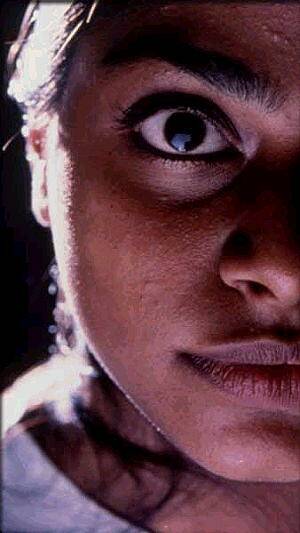 Loosely based on the assassination of Rajiv Ghandi, this focuses on Malli (Dharker), a 19-year old guerilla chosen as a suicide bomber. With flashbacks to earlier events, it covers the journey to the killing zone, where she awaits her target and her destiny.
Loosely based on the assassination of Rajiv Ghandi, this focuses on Malli (Dharker), a 19-year old guerilla chosen as a suicide bomber. With flashbacks to earlier events, it covers the journey to the killing zone, where she awaits her target and her destiny.
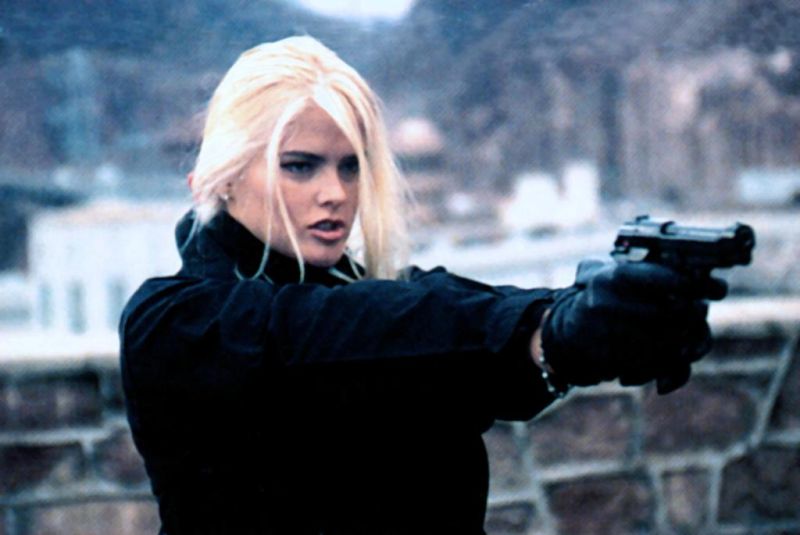
 ★★★★
★★★★
 But to quote one character in the movie, “Bitches from
But to quote one character in the movie, “Bitches from  It becomes like having Andrea Dworkin yelling in your face for two hours, yet the film’s moral is that if women empower themselves, death inevitably results. Khouri seems to be saying, “You can only beat the system by suicide,” while the patriarchy watches from behind its sunglasses and firearms. We
It becomes like having Andrea Dworkin yelling in your face for two hours, yet the film’s moral is that if women empower themselves, death inevitably results. Khouri seems to be saying, “You can only beat the system by suicide,” while the patriarchy watches from behind its sunglasses and firearms. We 
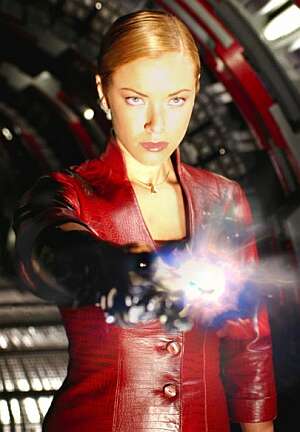 I feel a certain camaraderie with Arnie, since I’ve largely grown up alongside this series of movies, which is probably his finest work. I was at university when the first one came out; the second saw me living the life of a bachelor in London; and the latest installment finds me a happily married man in Arizona. Just as I’ve evolved, so have his opponents: they’ve become harder, faster and more difficult to kill; my sarcasm has been honed to a lethal edge, thanks to living with two teenagers and a pair of dogs.
I feel a certain camaraderie with Arnie, since I’ve largely grown up alongside this series of movies, which is probably his finest work. I was at university when the first one came out; the second saw me living the life of a bachelor in London; and the latest installment finds me a happily married man in Arizona. Just as I’ve evolved, so have his opponents: they’ve become harder, faster and more difficult to kill; my sarcasm has been honed to a lethal edge, thanks to living with two teenagers and a pair of dogs.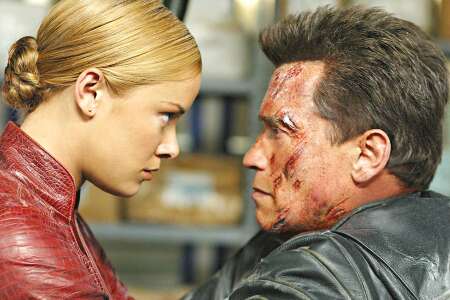 The plot is effectively a retread of the previous entry, with John Connor (Stahl) a drug-confused member of the underclass since his mother died of leukemia (possibly Hollywoodese for “Linda Hamilton wanted too much money”). He goes on the run with former schoolmate Kate (Danes), whose father just happens to be the guy in charge of SkyNet. What are the odds against that? These two are supposed to meet and fall in love, but there’s a bump on their road to happiness, in the shape of a nuclear war due to start at 6:18 pm that night.
The plot is effectively a retread of the previous entry, with John Connor (Stahl) a drug-confused member of the underclass since his mother died of leukemia (possibly Hollywoodese for “Linda Hamilton wanted too much money”). He goes on the run with former schoolmate Kate (Danes), whose father just happens to be the guy in charge of SkyNet. What are the odds against that? These two are supposed to meet and fall in love, but there’s a bump on their road to happiness, in the shape of a nuclear war due to start at 6:18 pm that night.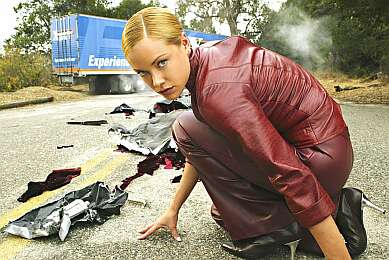 One interesting point, is that nobody ever mentions the T-X’s gender. The concept certainly held potential for a lot of PMS-type comments, but save for one minor joke involving Victoria’s Secret, sexuality is entirely kept out of things. The T-X, with her impossibly perfect hair and the coolest red leather jacket worn by a actress playing a superviolent female robot since Eve of Destruction, just goes about her business like an evil babysitter.
One interesting point, is that nobody ever mentions the T-X’s gender. The concept certainly held potential for a lot of PMS-type comments, but save for one minor joke involving Victoria’s Secret, sexuality is entirely kept out of things. The T-X, with her impossibly perfect hair and the coolest red leather jacket worn by a actress playing a superviolent female robot since Eve of Destruction, just goes about her business like an evil babysitter.